Mental Health Nursing Case Study: Amanda's Bipolar Disorder
VerifiedAdded on 2020/05/28
|11
|3031
|119
Case Study
AI Summary
This assignment presents a detailed case study of a patient, Amanda, diagnosed with bipolar disorder, exploring her history, symptoms, and treatment. The study highlights Amanda's history of manic episodes, suicidal tendencies, substance abuse, and family history of mood disorders. It delves into the signs and symptoms of bipolar disorder, differentiating between mania and depression, and linking them to Amanda's experiences. The assessment, evaluation, and nursing interventions are discussed, including pharmacological and non-pharmacological approaches such as medication management, electroconvulsive therapy, and various therapies. The role of the mental health nurse is also examined, focusing on patient care, ethical dilemmas, and the importance of a multidisciplinary team. This analysis provides insights into the complexities of bipolar disorder and the comprehensive care required for patients. The assignment underscores the need for continuous monitoring and tailored interventions to manage the peaks and troughs of the disorder and ensure patient safety and well-being.
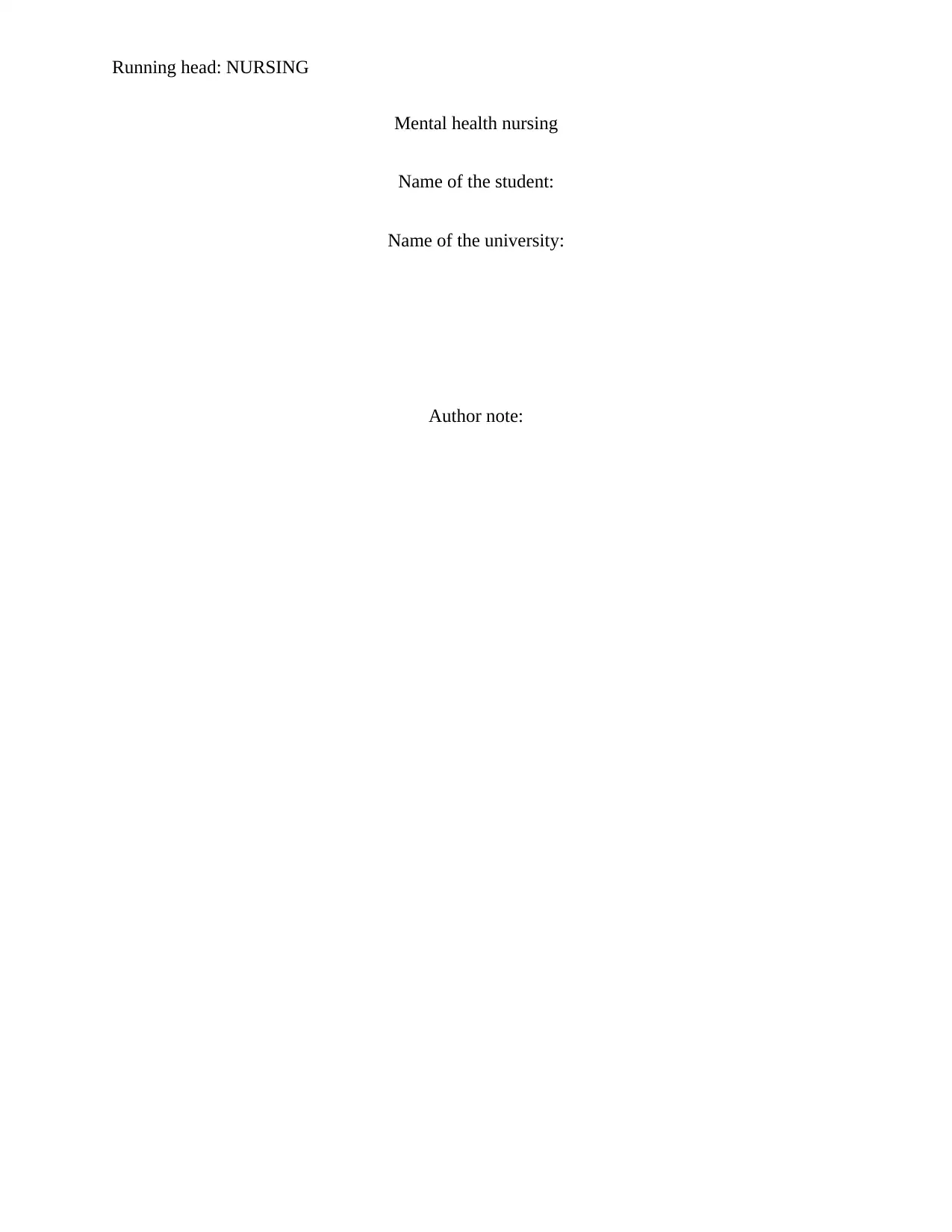
Running head: NURSING
Mental health nursing
Name of the student:
Name of the university:
Author note:
Mental health nursing
Name of the student:
Name of the university:
Author note:
Paraphrase This Document
Need a fresh take? Get an instant paraphrase of this document with our AI Paraphraser
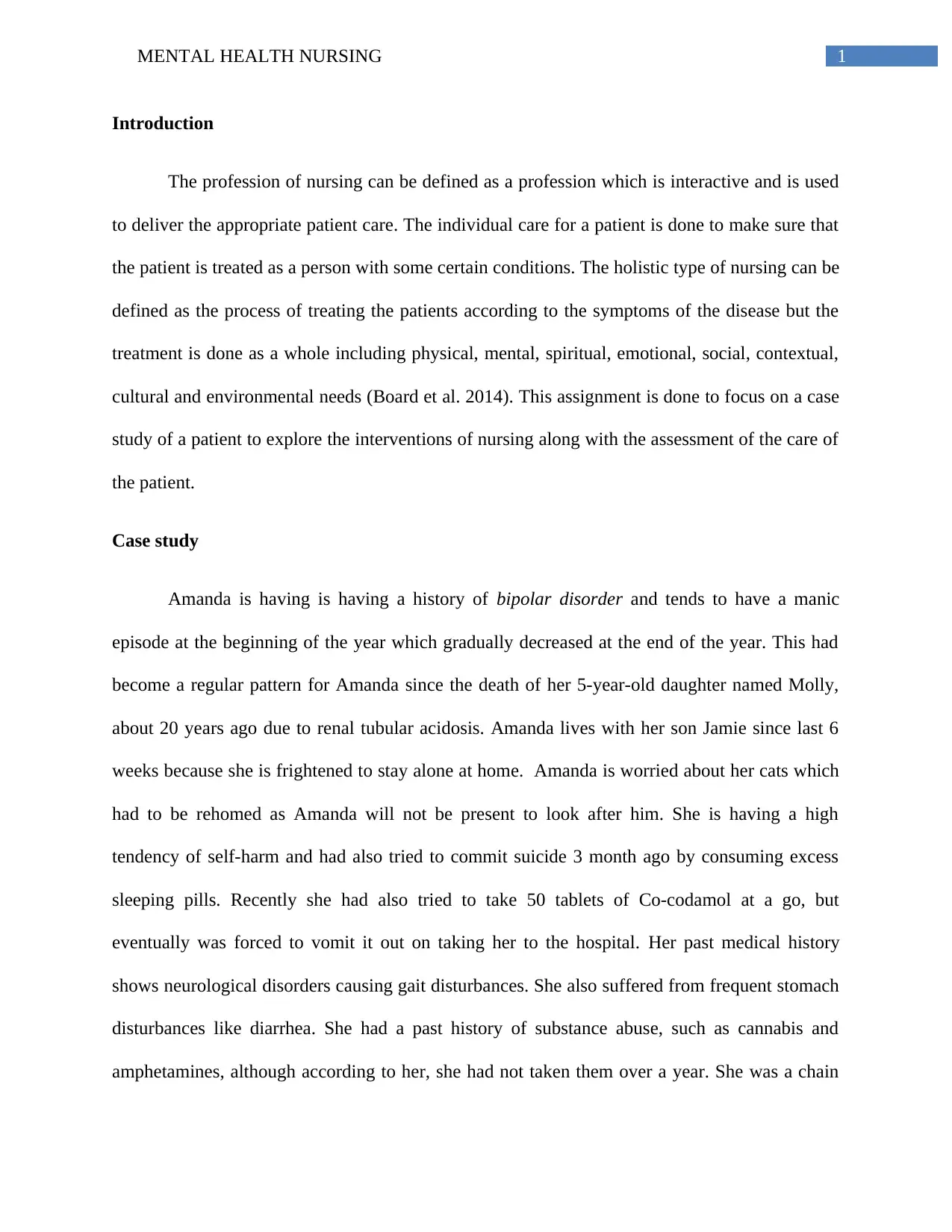
1MENTAL HEALTH NURSING
Introduction
The profession of nursing can be defined as a profession which is interactive and is used
to deliver the appropriate patient care. The individual care for a patient is done to make sure that
the patient is treated as a person with some certain conditions. The holistic type of nursing can be
defined as the process of treating the patients according to the symptoms of the disease but the
treatment is done as a whole including physical, mental, spiritual, emotional, social, contextual,
cultural and environmental needs (Board et al. 2014). This assignment is done to focus on a case
study of a patient to explore the interventions of nursing along with the assessment of the care of
the patient.
Case study
Amanda is having is having a history of bipolar disorder and tends to have a manic
episode at the beginning of the year which gradually decreased at the end of the year. This had
become a regular pattern for Amanda since the death of her 5-year-old daughter named Molly,
about 20 years ago due to renal tubular acidosis. Amanda lives with her son Jamie since last 6
weeks because she is frightened to stay alone at home. Amanda is worried about her cats which
had to be rehomed as Amanda will not be present to look after him. She is having a high
tendency of self-harm and had also tried to commit suicide 3 month ago by consuming excess
sleeping pills. Recently she had also tried to take 50 tablets of Co-codamol at a go, but
eventually was forced to vomit it out on taking her to the hospital. Her past medical history
shows neurological disorders causing gait disturbances. She also suffered from frequent stomach
disturbances like diarrhea. She had a past history of substance abuse, such as cannabis and
amphetamines, although according to her, she had not taken them over a year. She was a chain
Introduction
The profession of nursing can be defined as a profession which is interactive and is used
to deliver the appropriate patient care. The individual care for a patient is done to make sure that
the patient is treated as a person with some certain conditions. The holistic type of nursing can be
defined as the process of treating the patients according to the symptoms of the disease but the
treatment is done as a whole including physical, mental, spiritual, emotional, social, contextual,
cultural and environmental needs (Board et al. 2014). This assignment is done to focus on a case
study of a patient to explore the interventions of nursing along with the assessment of the care of
the patient.
Case study
Amanda is having is having a history of bipolar disorder and tends to have a manic
episode at the beginning of the year which gradually decreased at the end of the year. This had
become a regular pattern for Amanda since the death of her 5-year-old daughter named Molly,
about 20 years ago due to renal tubular acidosis. Amanda lives with her son Jamie since last 6
weeks because she is frightened to stay alone at home. Amanda is worried about her cats which
had to be rehomed as Amanda will not be present to look after him. She is having a high
tendency of self-harm and had also tried to commit suicide 3 month ago by consuming excess
sleeping pills. Recently she had also tried to take 50 tablets of Co-codamol at a go, but
eventually was forced to vomit it out on taking her to the hospital. Her past medical history
shows neurological disorders causing gait disturbances. She also suffered from frequent stomach
disturbances like diarrhea. She had a past history of substance abuse, such as cannabis and
amphetamines, although according to her, she had not taken them over a year. She was a chain
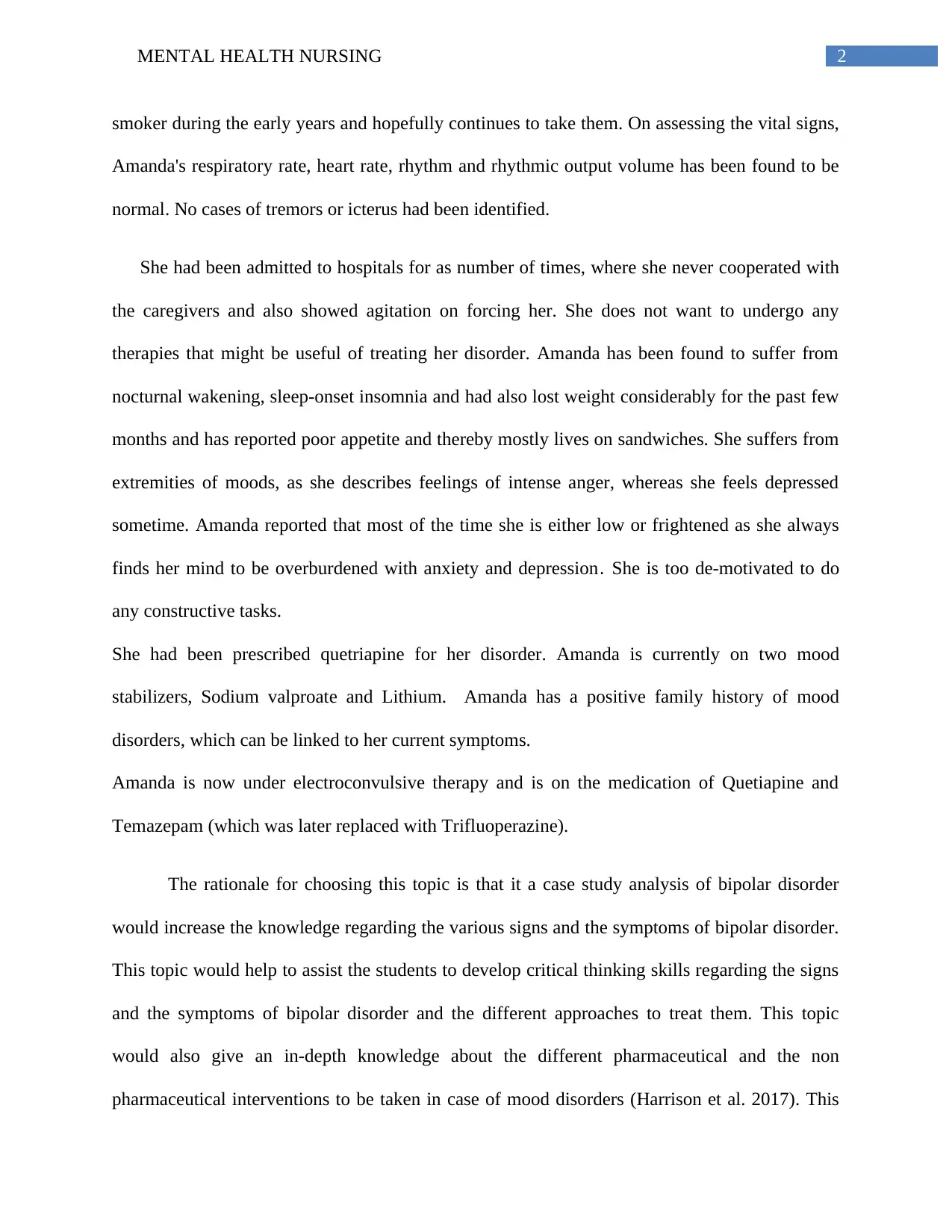
2MENTAL HEALTH NURSING
smoker during the early years and hopefully continues to take them. On assessing the vital signs,
Amanda's respiratory rate, heart rate, rhythm and rhythmic output volume has been found to be
normal. No cases of tremors or icterus had been identified.
She had been admitted to hospitals for as number of times, where she never cooperated with
the caregivers and also showed agitation on forcing her. She does not want to undergo any
therapies that might be useful of treating her disorder. Amanda has been found to suffer from
nocturnal wakening, sleep-onset insomnia and had also lost weight considerably for the past few
months and has reported poor appetite and thereby mostly lives on sandwiches. She suffers from
extremities of moods, as she describes feelings of intense anger, whereas she feels depressed
sometime. Amanda reported that most of the time she is either low or frightened as she always
finds her mind to be overburdened with anxiety and depression. She is too de-motivated to do
any constructive tasks.
She had been prescribed quetriapine for her disorder. Amanda is currently on two mood
stabilizers, Sodium valproate and Lithium. Amanda has a positive family history of mood
disorders, which can be linked to her current symptoms.
Amanda is now under electroconvulsive therapy and is on the medication of Quetiapine and
Temazepam (which was later replaced with Trifluoperazine).
The rationale for choosing this topic is that it a case study analysis of bipolar disorder
would increase the knowledge regarding the various signs and the symptoms of bipolar disorder.
This topic would help to assist the students to develop critical thinking skills regarding the signs
and the symptoms of bipolar disorder and the different approaches to treat them. This topic
would also give an in-depth knowledge about the different pharmaceutical and the non
pharmaceutical interventions to be taken in case of mood disorders (Harrison et al. 2017). This
smoker during the early years and hopefully continues to take them. On assessing the vital signs,
Amanda's respiratory rate, heart rate, rhythm and rhythmic output volume has been found to be
normal. No cases of tremors or icterus had been identified.
She had been admitted to hospitals for as number of times, where she never cooperated with
the caregivers and also showed agitation on forcing her. She does not want to undergo any
therapies that might be useful of treating her disorder. Amanda has been found to suffer from
nocturnal wakening, sleep-onset insomnia and had also lost weight considerably for the past few
months and has reported poor appetite and thereby mostly lives on sandwiches. She suffers from
extremities of moods, as she describes feelings of intense anger, whereas she feels depressed
sometime. Amanda reported that most of the time she is either low or frightened as she always
finds her mind to be overburdened with anxiety and depression. She is too de-motivated to do
any constructive tasks.
She had been prescribed quetriapine for her disorder. Amanda is currently on two mood
stabilizers, Sodium valproate and Lithium. Amanda has a positive family history of mood
disorders, which can be linked to her current symptoms.
Amanda is now under electroconvulsive therapy and is on the medication of Quetiapine and
Temazepam (which was later replaced with Trifluoperazine).
The rationale for choosing this topic is that it a case study analysis of bipolar disorder
would increase the knowledge regarding the various signs and the symptoms of bipolar disorder.
This topic would help to assist the students to develop critical thinking skills regarding the signs
and the symptoms of bipolar disorder and the different approaches to treat them. This topic
would also give an in-depth knowledge about the different pharmaceutical and the non
pharmaceutical interventions to be taken in case of mood disorders (Harrison et al. 2017). This
⊘ This is a preview!⊘
Do you want full access?
Subscribe today to unlock all pages.

Trusted by 1+ million students worldwide
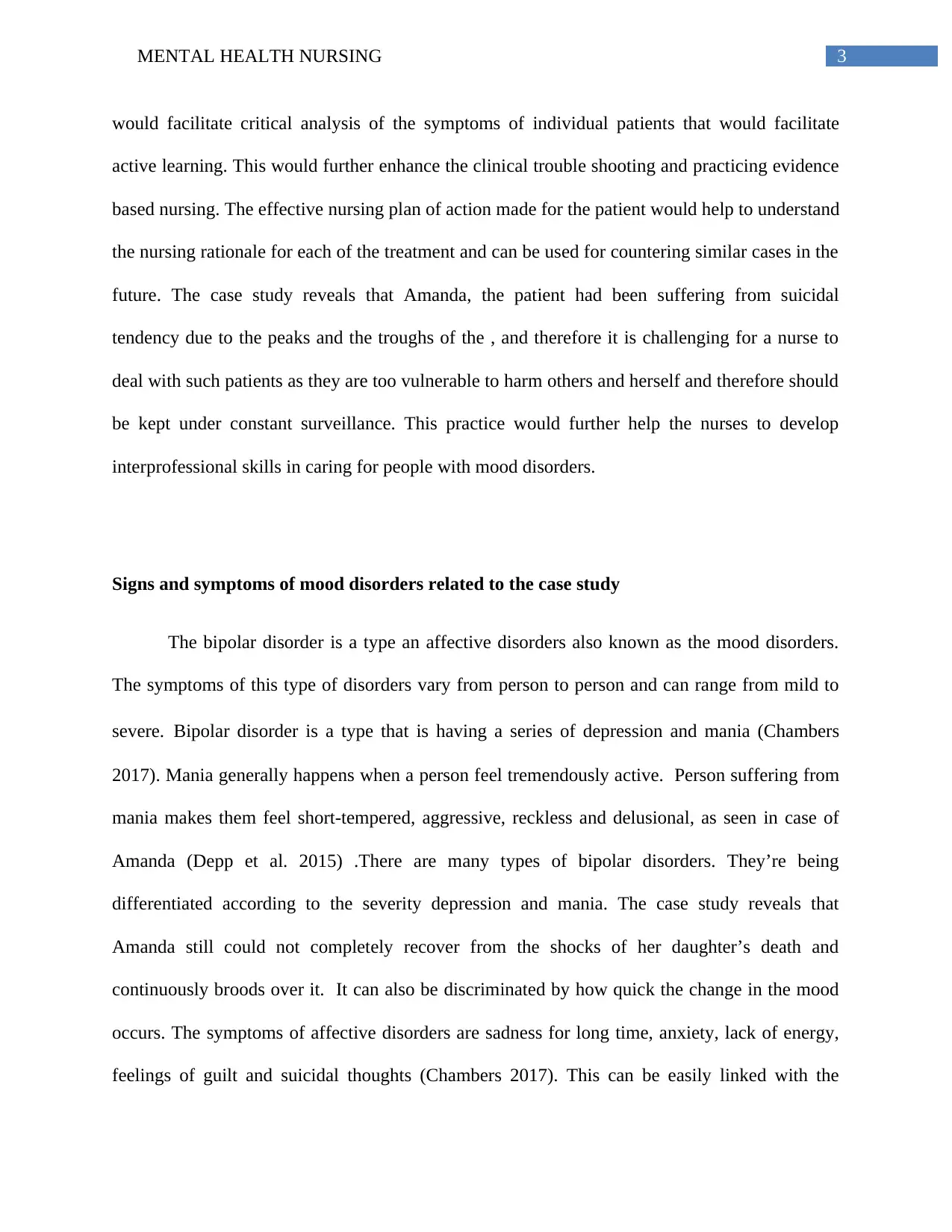
3MENTAL HEALTH NURSING
would facilitate critical analysis of the symptoms of individual patients that would facilitate
active learning. This would further enhance the clinical trouble shooting and practicing evidence
based nursing. The effective nursing plan of action made for the patient would help to understand
the nursing rationale for each of the treatment and can be used for countering similar cases in the
future. The case study reveals that Amanda, the patient had been suffering from suicidal
tendency due to the peaks and the troughs of the , and therefore it is challenging for a nurse to
deal with such patients as they are too vulnerable to harm others and herself and therefore should
be kept under constant surveillance. This practice would further help the nurses to develop
interprofessional skills in caring for people with mood disorders.
Signs and symptoms of mood disorders related to the case study
The bipolar disorder is a type an affective disorders also known as the mood disorders.
The symptoms of this type of disorders vary from person to person and can range from mild to
severe. Bipolar disorder is a type that is having a series of depression and mania (Chambers
2017). Mania generally happens when a person feel tremendously active. Person suffering from
mania makes them feel short-tempered, aggressive, reckless and delusional, as seen in case of
Amanda (Depp et al. 2015) .There are many types of bipolar disorders. They’re being
differentiated according to the severity depression and mania. The case study reveals that
Amanda still could not completely recover from the shocks of her daughter’s death and
continuously broods over it. It can also be discriminated by how quick the change in the mood
occurs. The symptoms of affective disorders are sadness for long time, anxiety, lack of energy,
feelings of guilt and suicidal thoughts (Chambers 2017). This can be easily linked with the
would facilitate critical analysis of the symptoms of individual patients that would facilitate
active learning. This would further enhance the clinical trouble shooting and practicing evidence
based nursing. The effective nursing plan of action made for the patient would help to understand
the nursing rationale for each of the treatment and can be used for countering similar cases in the
future. The case study reveals that Amanda, the patient had been suffering from suicidal
tendency due to the peaks and the troughs of the , and therefore it is challenging for a nurse to
deal with such patients as they are too vulnerable to harm others and herself and therefore should
be kept under constant surveillance. This practice would further help the nurses to develop
interprofessional skills in caring for people with mood disorders.
Signs and symptoms of mood disorders related to the case study
The bipolar disorder is a type an affective disorders also known as the mood disorders.
The symptoms of this type of disorders vary from person to person and can range from mild to
severe. Bipolar disorder is a type that is having a series of depression and mania (Chambers
2017). Mania generally happens when a person feel tremendously active. Person suffering from
mania makes them feel short-tempered, aggressive, reckless and delusional, as seen in case of
Amanda (Depp et al. 2015) .There are many types of bipolar disorders. They’re being
differentiated according to the severity depression and mania. The case study reveals that
Amanda still could not completely recover from the shocks of her daughter’s death and
continuously broods over it. It can also be discriminated by how quick the change in the mood
occurs. The symptoms of affective disorders are sadness for long time, anxiety, lack of energy,
feelings of guilt and suicidal thoughts (Chambers 2017). This can be easily linked with the
Paraphrase This Document
Need a fresh take? Get an instant paraphrase of this document with our AI Paraphraser

4MENTAL HEALTH NURSING
suicidal episodes such as self hurting by consuming sleeping pills or self cutting by a knife. As
told earlier that people with bipolar disorder often have nocturnal awakenings, which can again
be related to Amanda's sleeping disorders. Substance abuse can exacerbate the symptoms of
mood disorders (Fortinash and Worret 2014). Amanda had a past history of drugs and alcohol
which can be linked to her current health status.
Assessment, Evaluation and nursing interventions
According to McCormick (2015), Bipolar Disorder has considerable lifetime
predominance in the populace at 4%. The peaks and the troughs of BD can relapse from time to
time; the condition is related with critical weight to the patient, parental figures, and the
community. According to Tsu (2016), Bipolar disorder is an interminable disease that causes
intermittent moves in state of mind through scenes of dysthymia, discouragement, hypomania,
and agitation (Chambers 2017). There are two noteworthy kinds of bipolar issue: bipolar I issue,
which is described by the nearness of no less than one intense hyper scene, and bipolar II issue,
which is exemplified by hypomania and longer depressive scenes and is now and again
misdiagnosed as real depressive issue. Pharmaco-therapeutic alternatives incorporate lithium,
anticonvulsants, antipsychotics, and antidepressants (Baker et al. 2014). Drug specialists assume
a part in guaranteeing legitimate dosing regimens, checking for sedate connections, and
observing for potential medication lethality. When directing the patients, drug specialists should
survey time of the administration and potential reactions for verifying that the patient has an
extensive comprehension of the ways to oversee side effects. Bipolar disorders are challenging to
identify and are mainly characterised by high levels of aggression, agitation and dysregulation.
Patients with bipolar disease are often associated with cyclothymia, having numerous phases of
depressive and hypo-maniac symptoms (Hirschfeld 2014). This can be easily linked with the
suicidal episodes such as self hurting by consuming sleeping pills or self cutting by a knife. As
told earlier that people with bipolar disorder often have nocturnal awakenings, which can again
be related to Amanda's sleeping disorders. Substance abuse can exacerbate the symptoms of
mood disorders (Fortinash and Worret 2014). Amanda had a past history of drugs and alcohol
which can be linked to her current health status.
Assessment, Evaluation and nursing interventions
According to McCormick (2015), Bipolar Disorder has considerable lifetime
predominance in the populace at 4%. The peaks and the troughs of BD can relapse from time to
time; the condition is related with critical weight to the patient, parental figures, and the
community. According to Tsu (2016), Bipolar disorder is an interminable disease that causes
intermittent moves in state of mind through scenes of dysthymia, discouragement, hypomania,
and agitation (Chambers 2017). There are two noteworthy kinds of bipolar issue: bipolar I issue,
which is described by the nearness of no less than one intense hyper scene, and bipolar II issue,
which is exemplified by hypomania and longer depressive scenes and is now and again
misdiagnosed as real depressive issue. Pharmaco-therapeutic alternatives incorporate lithium,
anticonvulsants, antipsychotics, and antidepressants (Baker et al. 2014). Drug specialists assume
a part in guaranteeing legitimate dosing regimens, checking for sedate connections, and
observing for potential medication lethality. When directing the patients, drug specialists should
survey time of the administration and potential reactions for verifying that the patient has an
extensive comprehension of the ways to oversee side effects. Bipolar disorders are challenging to
identify and are mainly characterised by high levels of aggression, agitation and dysregulation.
Patients with bipolar disease are often associated with cyclothymia, having numerous phases of
depressive and hypo-maniac symptoms (Hirschfeld 2014). This can be easily linked with the
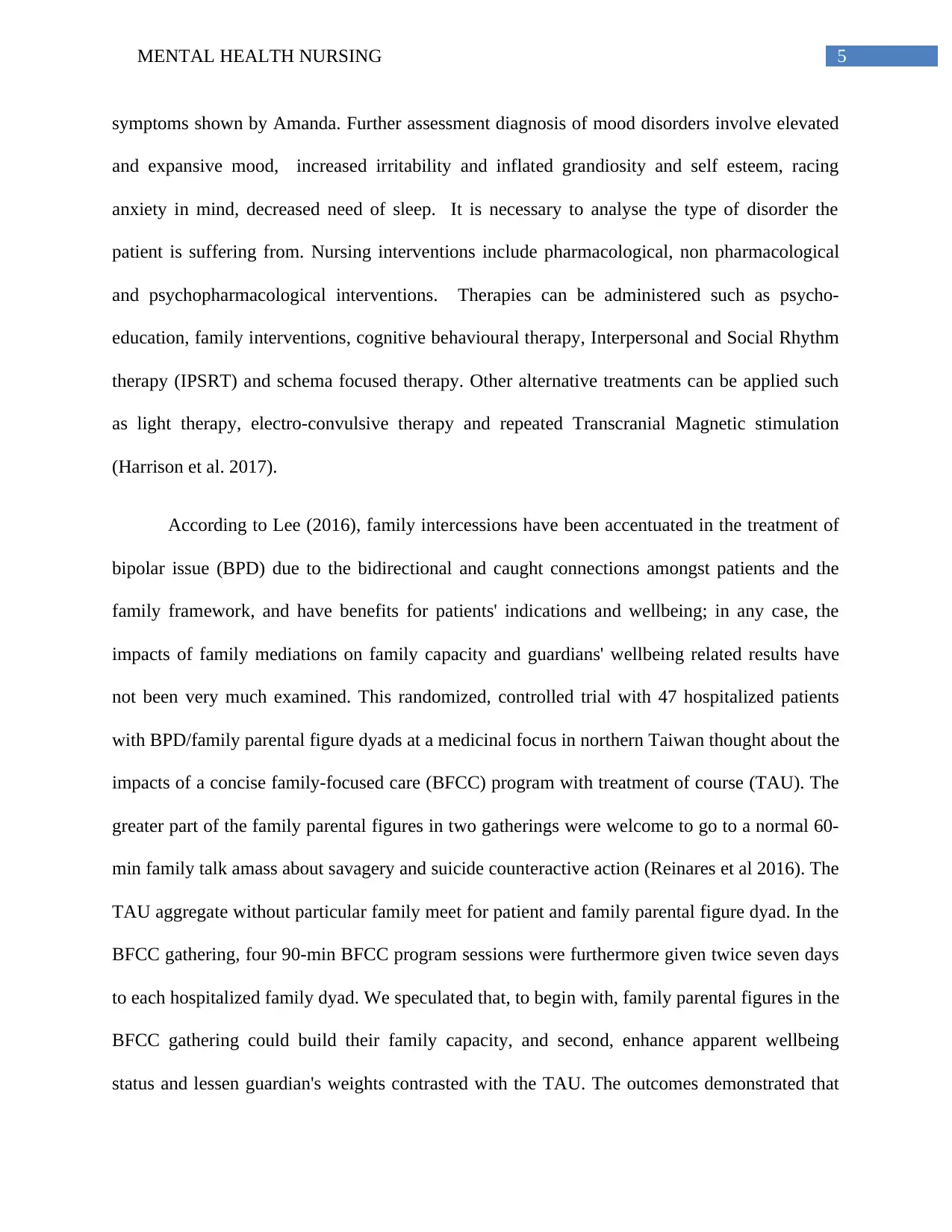
5MENTAL HEALTH NURSING
symptoms shown by Amanda. Further assessment diagnosis of mood disorders involve elevated
and expansive mood, increased irritability and inflated grandiosity and self esteem, racing
anxiety in mind, decreased need of sleep. It is necessary to analyse the type of disorder the
patient is suffering from. Nursing interventions include pharmacological, non pharmacological
and psychopharmacological interventions. Therapies can be administered such as psycho-
education, family interventions, cognitive behavioural therapy, Interpersonal and Social Rhythm
therapy (IPSRT) and schema focused therapy. Other alternative treatments can be applied such
as light therapy, electro-convulsive therapy and repeated Transcranial Magnetic stimulation
(Harrison et al. 2017).
According to Lee (2016), family intercessions have been accentuated in the treatment of
bipolar issue (BPD) due to the bidirectional and caught connections amongst patients and the
family framework, and have benefits for patients' indications and wellbeing; in any case, the
impacts of family mediations on family capacity and guardians' wellbeing related results have
not been very much examined. This randomized, controlled trial with 47 hospitalized patients
with BPD/family parental figure dyads at a medicinal focus in northern Taiwan thought about the
impacts of a concise family-focused care (BFCC) program with treatment of course (TAU). The
greater part of the family parental figures in two gatherings were welcome to go to a normal 60-
min family talk amass about savagery and suicide counteractive action (Reinares et al 2016). The
TAU aggregate without particular family meet for patient and family parental figure dyad. In the
BFCC gathering, four 90-min BFCC program sessions were furthermore given twice seven days
to each hospitalized family dyad. We speculated that, to begin with, family parental figures in the
BFCC gathering could build their family capacity, and second, enhance apparent wellbeing
status and lessen guardian's weights contrasted with the TAU. The outcomes demonstrated that
symptoms shown by Amanda. Further assessment diagnosis of mood disorders involve elevated
and expansive mood, increased irritability and inflated grandiosity and self esteem, racing
anxiety in mind, decreased need of sleep. It is necessary to analyse the type of disorder the
patient is suffering from. Nursing interventions include pharmacological, non pharmacological
and psychopharmacological interventions. Therapies can be administered such as psycho-
education, family interventions, cognitive behavioural therapy, Interpersonal and Social Rhythm
therapy (IPSRT) and schema focused therapy. Other alternative treatments can be applied such
as light therapy, electro-convulsive therapy and repeated Transcranial Magnetic stimulation
(Harrison et al. 2017).
According to Lee (2016), family intercessions have been accentuated in the treatment of
bipolar issue (BPD) due to the bidirectional and caught connections amongst patients and the
family framework, and have benefits for patients' indications and wellbeing; in any case, the
impacts of family mediations on family capacity and guardians' wellbeing related results have
not been very much examined. This randomized, controlled trial with 47 hospitalized patients
with BPD/family parental figure dyads at a medicinal focus in northern Taiwan thought about the
impacts of a concise family-focused care (BFCC) program with treatment of course (TAU). The
greater part of the family parental figures in two gatherings were welcome to go to a normal 60-
min family talk amass about savagery and suicide counteractive action (Reinares et al 2016). The
TAU aggregate without particular family meet for patient and family parental figure dyad. In the
BFCC gathering, four 90-min BFCC program sessions were furthermore given twice seven days
to each hospitalized family dyad. We speculated that, to begin with, family parental figures in the
BFCC gathering could build their family capacity, and second, enhance apparent wellbeing
status and lessen guardian's weights contrasted with the TAU. The outcomes demonstrated that
⊘ This is a preview!⊘
Do you want full access?
Subscribe today to unlock all pages.

Trusted by 1+ million students worldwide
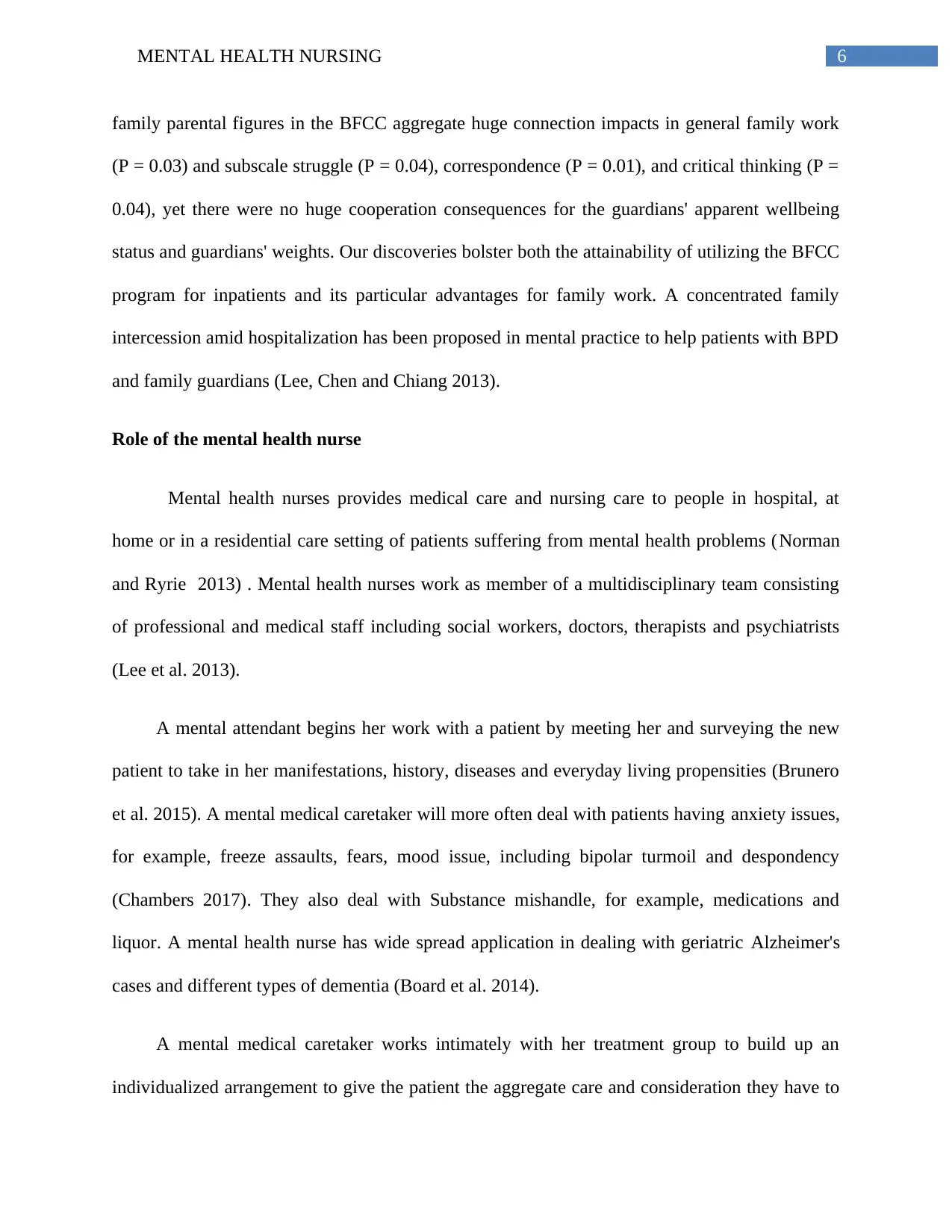
6MENTAL HEALTH NURSING
family parental figures in the BFCC aggregate huge connection impacts in general family work
(P = 0.03) and subscale struggle (P = 0.04), correspondence (P = 0.01), and critical thinking (P =
0.04), yet there were no huge cooperation consequences for the guardians' apparent wellbeing
status and guardians' weights. Our discoveries bolster both the attainability of utilizing the BFCC
program for inpatients and its particular advantages for family work. A concentrated family
intercession amid hospitalization has been proposed in mental practice to help patients with BPD
and family guardians (Lee, Chen and Chiang 2013).
Role of the mental health nurse
Mental health nurses provides medical care and nursing care to people in hospital, at
home or in a residential care setting of patients suffering from mental health problems (Norman
and Ryrie 2013) . Mental health nurses work as member of a multidisciplinary team consisting
of professional and medical staff including social workers, doctors, therapists and psychiatrists
(Lee et al. 2013).
A mental attendant begins her work with a patient by meeting her and surveying the new
patient to take in her manifestations, history, diseases and everyday living propensities (Brunero
et al. 2015). A mental medical caretaker will more often deal with patients having anxiety issues,
for example, freeze assaults, fears, mood issue, including bipolar turmoil and despondency
(Chambers 2017). They also deal with Substance mishandle, for example, medications and
liquor. A mental health nurse has wide spread application in dealing with geriatric Alzheimer's
cases and different types of dementia (Board et al. 2014).
A mental medical caretaker works intimately with her treatment group to build up an
individualized arrangement to give the patient the aggregate care and consideration they have to
family parental figures in the BFCC aggregate huge connection impacts in general family work
(P = 0.03) and subscale struggle (P = 0.04), correspondence (P = 0.01), and critical thinking (P =
0.04), yet there were no huge cooperation consequences for the guardians' apparent wellbeing
status and guardians' weights. Our discoveries bolster both the attainability of utilizing the BFCC
program for inpatients and its particular advantages for family work. A concentrated family
intercession amid hospitalization has been proposed in mental practice to help patients with BPD
and family guardians (Lee, Chen and Chiang 2013).
Role of the mental health nurse
Mental health nurses provides medical care and nursing care to people in hospital, at
home or in a residential care setting of patients suffering from mental health problems (Norman
and Ryrie 2013) . Mental health nurses work as member of a multidisciplinary team consisting
of professional and medical staff including social workers, doctors, therapists and psychiatrists
(Lee et al. 2013).
A mental attendant begins her work with a patient by meeting her and surveying the new
patient to take in her manifestations, history, diseases and everyday living propensities (Brunero
et al. 2015). A mental medical caretaker will more often deal with patients having anxiety issues,
for example, freeze assaults, fears, mood issue, including bipolar turmoil and despondency
(Chambers 2017). They also deal with Substance mishandle, for example, medications and
liquor. A mental health nurse has wide spread application in dealing with geriatric Alzheimer's
cases and different types of dementia (Board et al. 2014).
A mental medical caretaker works intimately with her treatment group to build up an
individualized arrangement to give the patient the aggregate care and consideration they have to
Paraphrase This Document
Need a fresh take? Get an instant paraphrase of this document with our AI Paraphraser
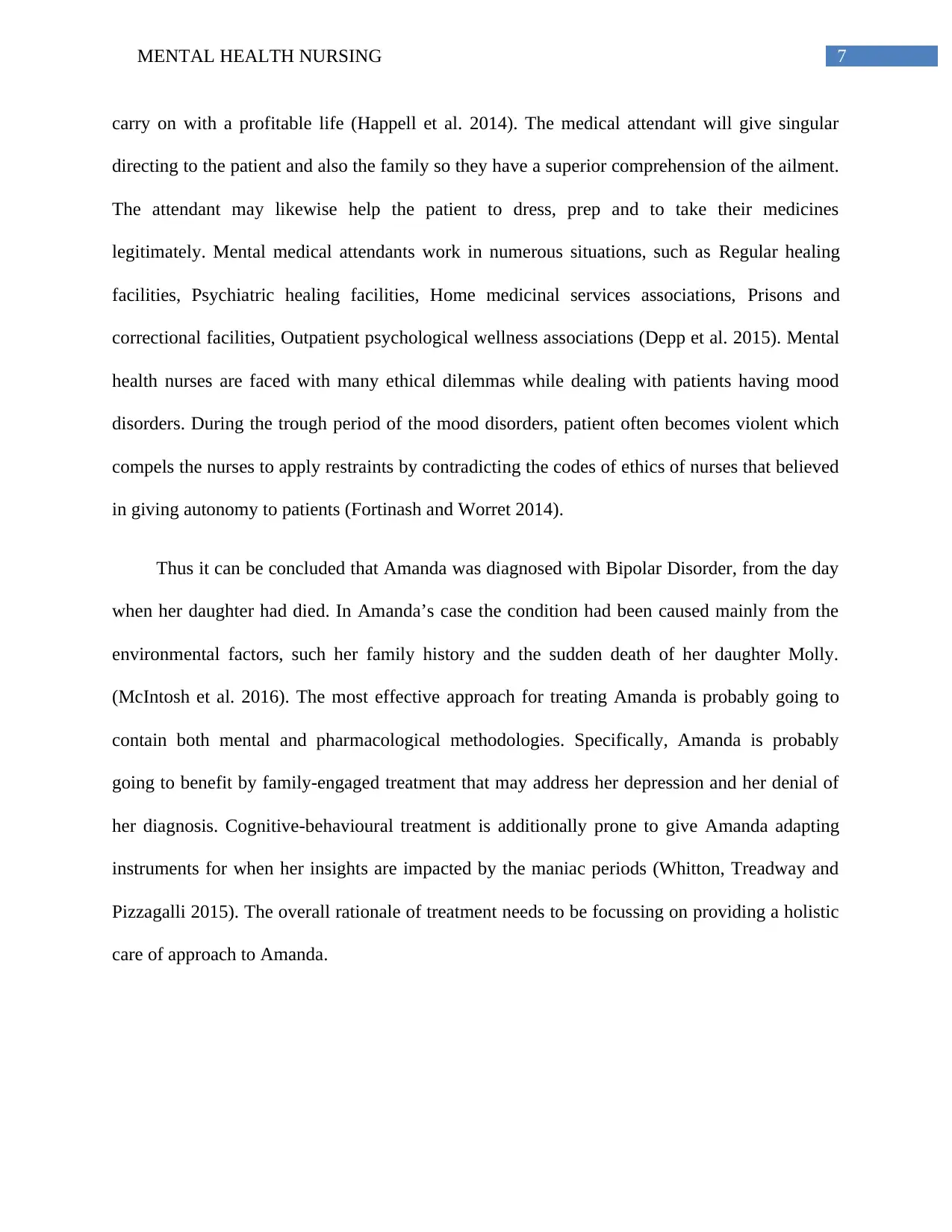
7MENTAL HEALTH NURSING
carry on with a profitable life (Happell et al. 2014). The medical attendant will give singular
directing to the patient and also the family so they have a superior comprehension of the ailment.
The attendant may likewise help the patient to dress, prep and to take their medicines
legitimately. Mental medical attendants work in numerous situations, such as Regular healing
facilities, Psychiatric healing facilities, Home medicinal services associations, Prisons and
correctional facilities, Outpatient psychological wellness associations (Depp et al. 2015). Mental
health nurses are faced with many ethical dilemmas while dealing with patients having mood
disorders. During the trough period of the mood disorders, patient often becomes violent which
compels the nurses to apply restraints by contradicting the codes of ethics of nurses that believed
in giving autonomy to patients (Fortinash and Worret 2014).
Thus it can be concluded that Amanda was diagnosed with Bipolar Disorder, from the day
when her daughter had died. In Amanda’s case the condition had been caused mainly from the
environmental factors, such her family history and the sudden death of her daughter Molly.
(McIntosh et al. 2016). The most effective approach for treating Amanda is probably going to
contain both mental and pharmacological methodologies. Specifically, Amanda is probably
going to benefit by family-engaged treatment that may address her depression and her denial of
her diagnosis. Cognitive-behavioural treatment is additionally prone to give Amanda adapting
instruments for when her insights are impacted by the maniac periods (Whitton, Treadway and
Pizzagalli 2015). The overall rationale of treatment needs to be focussing on providing a holistic
care of approach to Amanda.
carry on with a profitable life (Happell et al. 2014). The medical attendant will give singular
directing to the patient and also the family so they have a superior comprehension of the ailment.
The attendant may likewise help the patient to dress, prep and to take their medicines
legitimately. Mental medical attendants work in numerous situations, such as Regular healing
facilities, Psychiatric healing facilities, Home medicinal services associations, Prisons and
correctional facilities, Outpatient psychological wellness associations (Depp et al. 2015). Mental
health nurses are faced with many ethical dilemmas while dealing with patients having mood
disorders. During the trough period of the mood disorders, patient often becomes violent which
compels the nurses to apply restraints by contradicting the codes of ethics of nurses that believed
in giving autonomy to patients (Fortinash and Worret 2014).
Thus it can be concluded that Amanda was diagnosed with Bipolar Disorder, from the day
when her daughter had died. In Amanda’s case the condition had been caused mainly from the
environmental factors, such her family history and the sudden death of her daughter Molly.
(McIntosh et al. 2016). The most effective approach for treating Amanda is probably going to
contain both mental and pharmacological methodologies. Specifically, Amanda is probably
going to benefit by family-engaged treatment that may address her depression and her denial of
her diagnosis. Cognitive-behavioural treatment is additionally prone to give Amanda adapting
instruments for when her insights are impacted by the maniac periods (Whitton, Treadway and
Pizzagalli 2015). The overall rationale of treatment needs to be focussing on providing a holistic
care of approach to Amanda.
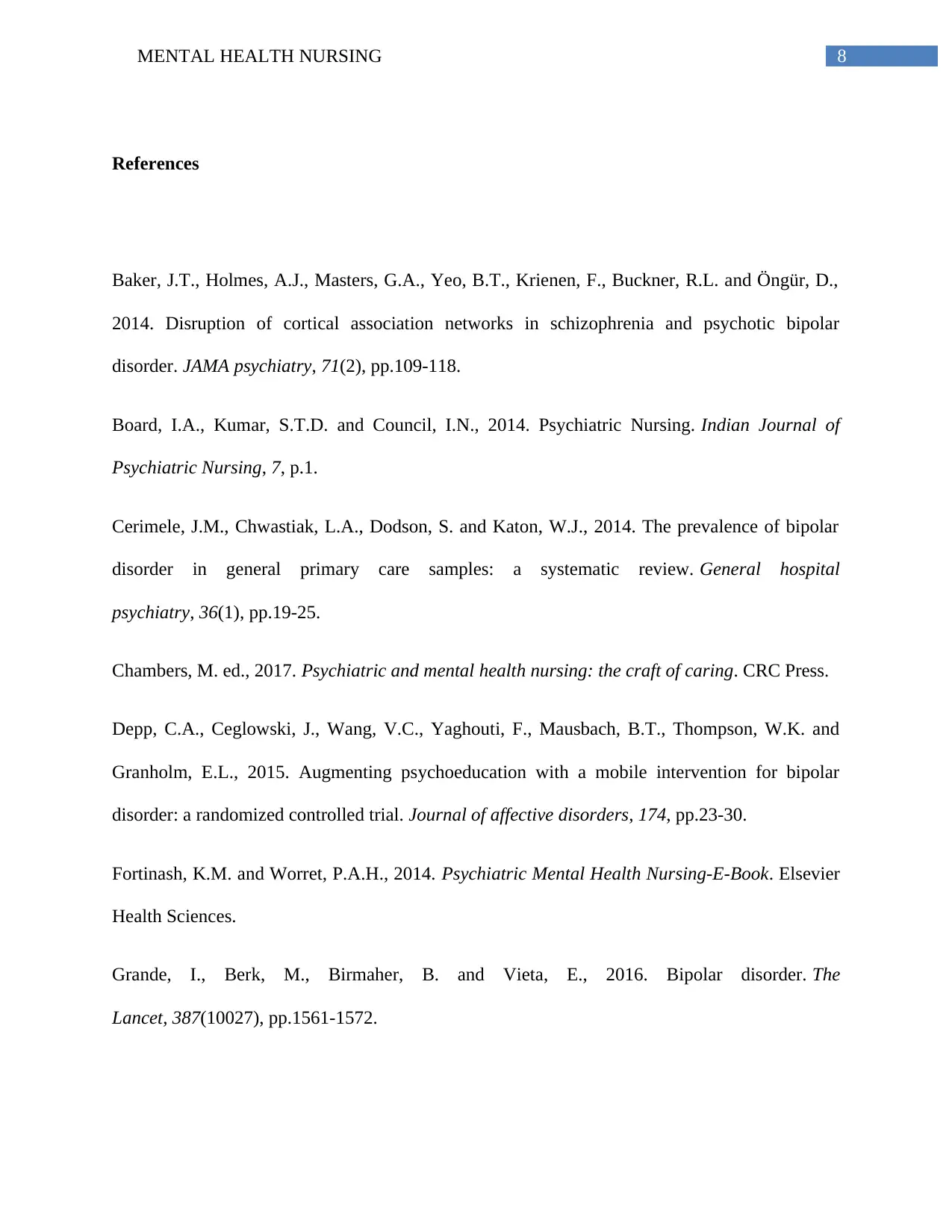
8MENTAL HEALTH NURSING
References
Baker, J.T., Holmes, A.J., Masters, G.A., Yeo, B.T., Krienen, F., Buckner, R.L. and Öngür, D.,
2014. Disruption of cortical association networks in schizophrenia and psychotic bipolar
disorder. JAMA psychiatry, 71(2), pp.109-118.
Board, I.A., Kumar, S.T.D. and Council, I.N., 2014. Psychiatric Nursing. Indian Journal of
Psychiatric Nursing, 7, p.1.
Cerimele, J.M., Chwastiak, L.A., Dodson, S. and Katon, W.J., 2014. The prevalence of bipolar
disorder in general primary care samples: a systematic review. General hospital
psychiatry, 36(1), pp.19-25.
Chambers, M. ed., 2017. Psychiatric and mental health nursing: the craft of caring. CRC Press.
Depp, C.A., Ceglowski, J., Wang, V.C., Yaghouti, F., Mausbach, B.T., Thompson, W.K. and
Granholm, E.L., 2015. Augmenting psychoeducation with a mobile intervention for bipolar
disorder: a randomized controlled trial. Journal of affective disorders, 174, pp.23-30.
Fortinash, K.M. and Worret, P.A.H., 2014. Psychiatric Mental Health Nursing-E-Book. Elsevier
Health Sciences.
Grande, I., Berk, M., Birmaher, B. and Vieta, E., 2016. Bipolar disorder. The
Lancet, 387(10027), pp.1561-1572.
References
Baker, J.T., Holmes, A.J., Masters, G.A., Yeo, B.T., Krienen, F., Buckner, R.L. and Öngür, D.,
2014. Disruption of cortical association networks in schizophrenia and psychotic bipolar
disorder. JAMA psychiatry, 71(2), pp.109-118.
Board, I.A., Kumar, S.T.D. and Council, I.N., 2014. Psychiatric Nursing. Indian Journal of
Psychiatric Nursing, 7, p.1.
Cerimele, J.M., Chwastiak, L.A., Dodson, S. and Katon, W.J., 2014. The prevalence of bipolar
disorder in general primary care samples: a systematic review. General hospital
psychiatry, 36(1), pp.19-25.
Chambers, M. ed., 2017. Psychiatric and mental health nursing: the craft of caring. CRC Press.
Depp, C.A., Ceglowski, J., Wang, V.C., Yaghouti, F., Mausbach, B.T., Thompson, W.K. and
Granholm, E.L., 2015. Augmenting psychoeducation with a mobile intervention for bipolar
disorder: a randomized controlled trial. Journal of affective disorders, 174, pp.23-30.
Fortinash, K.M. and Worret, P.A.H., 2014. Psychiatric Mental Health Nursing-E-Book. Elsevier
Health Sciences.
Grande, I., Berk, M., Birmaher, B. and Vieta, E., 2016. Bipolar disorder. The
Lancet, 387(10027), pp.1561-1572.
⊘ This is a preview!⊘
Do you want full access?
Subscribe today to unlock all pages.

Trusted by 1+ million students worldwide
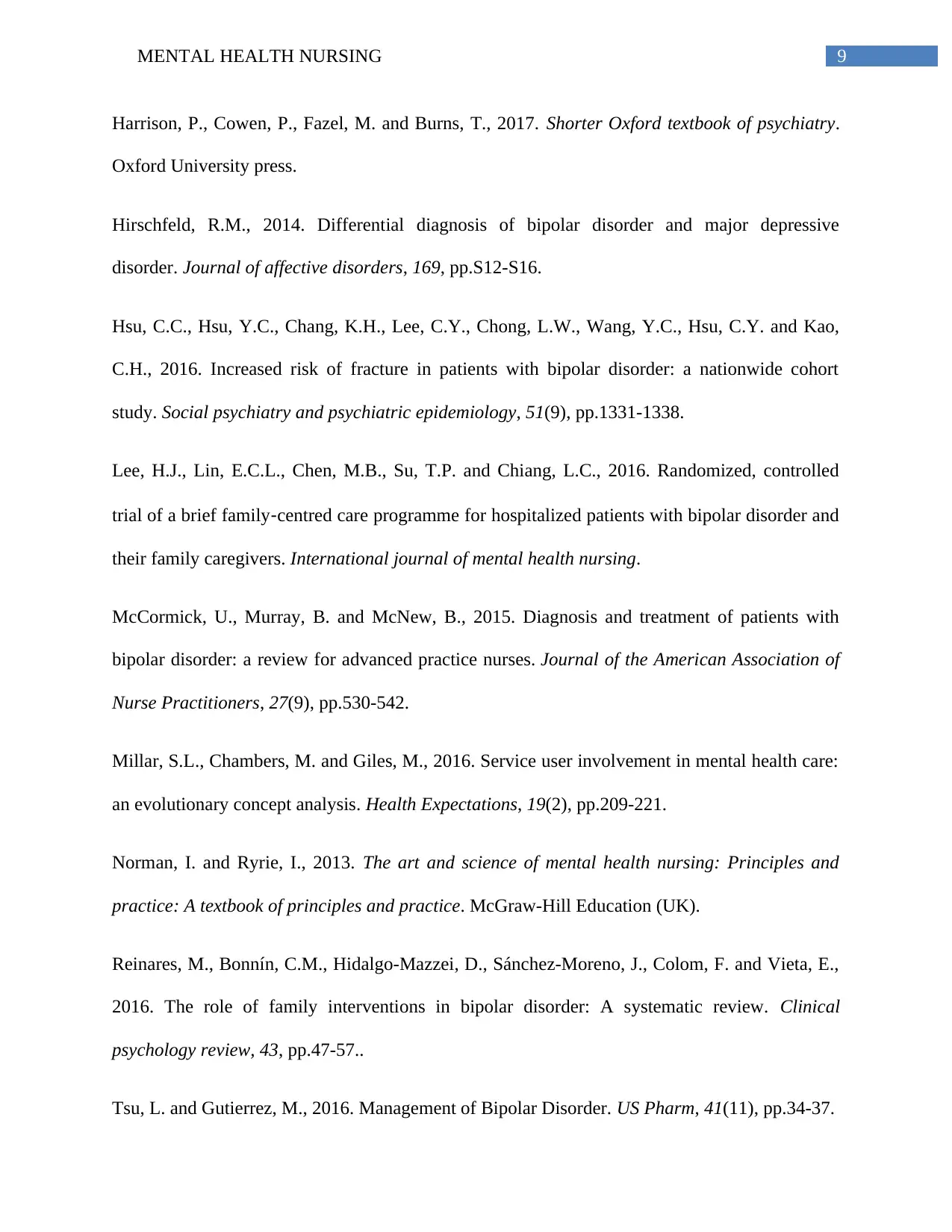
9MENTAL HEALTH NURSING
Harrison, P., Cowen, P., Fazel, M. and Burns, T., 2017. Shorter Oxford textbook of psychiatry.
Oxford University press.
Hirschfeld, R.M., 2014. Differential diagnosis of bipolar disorder and major depressive
disorder. Journal of affective disorders, 169, pp.S12-S16.
Hsu, C.C., Hsu, Y.C., Chang, K.H., Lee, C.Y., Chong, L.W., Wang, Y.C., Hsu, C.Y. and Kao,
C.H., 2016. Increased risk of fracture in patients with bipolar disorder: a nationwide cohort
study. Social psychiatry and psychiatric epidemiology, 51(9), pp.1331-1338.
Lee, H.J., Lin, E.C.L., Chen, M.B., Su, T.P. and Chiang, L.C., 2016. Randomized, controlled
trial of a brief family‐centred care programme for hospitalized patients with bipolar disorder and
their family caregivers. International journal of mental health nursing.
McCormick, U., Murray, B. and McNew, B., 2015. Diagnosis and treatment of patients with
bipolar disorder: a review for advanced practice nurses. Journal of the American Association of
Nurse Practitioners, 27(9), pp.530-542.
Millar, S.L., Chambers, M. and Giles, M., 2016. Service user involvement in mental health care:
an evolutionary concept analysis. Health Expectations, 19(2), pp.209-221.
Norman, I. and Ryrie, I., 2013. The art and science of mental health nursing: Principles and
practice: A textbook of principles and practice. McGraw-Hill Education (UK).
Reinares, M., Bonnín, C.M., Hidalgo-Mazzei, D., Sánchez-Moreno, J., Colom, F. and Vieta, E.,
2016. The role of family interventions in bipolar disorder: A systematic review. Clinical
psychology review, 43, pp.47-57..
Tsu, L. and Gutierrez, M., 2016. Management of Bipolar Disorder. US Pharm, 41(11), pp.34-37.
Harrison, P., Cowen, P., Fazel, M. and Burns, T., 2017. Shorter Oxford textbook of psychiatry.
Oxford University press.
Hirschfeld, R.M., 2014. Differential diagnosis of bipolar disorder and major depressive
disorder. Journal of affective disorders, 169, pp.S12-S16.
Hsu, C.C., Hsu, Y.C., Chang, K.H., Lee, C.Y., Chong, L.W., Wang, Y.C., Hsu, C.Y. and Kao,
C.H., 2016. Increased risk of fracture in patients with bipolar disorder: a nationwide cohort
study. Social psychiatry and psychiatric epidemiology, 51(9), pp.1331-1338.
Lee, H.J., Lin, E.C.L., Chen, M.B., Su, T.P. and Chiang, L.C., 2016. Randomized, controlled
trial of a brief family‐centred care programme for hospitalized patients with bipolar disorder and
their family caregivers. International journal of mental health nursing.
McCormick, U., Murray, B. and McNew, B., 2015. Diagnosis and treatment of patients with
bipolar disorder: a review for advanced practice nurses. Journal of the American Association of
Nurse Practitioners, 27(9), pp.530-542.
Millar, S.L., Chambers, M. and Giles, M., 2016. Service user involvement in mental health care:
an evolutionary concept analysis. Health Expectations, 19(2), pp.209-221.
Norman, I. and Ryrie, I., 2013. The art and science of mental health nursing: Principles and
practice: A textbook of principles and practice. McGraw-Hill Education (UK).
Reinares, M., Bonnín, C.M., Hidalgo-Mazzei, D., Sánchez-Moreno, J., Colom, F. and Vieta, E.,
2016. The role of family interventions in bipolar disorder: A systematic review. Clinical
psychology review, 43, pp.47-57..
Tsu, L. and Gutierrez, M., 2016. Management of Bipolar Disorder. US Pharm, 41(11), pp.34-37.
Paraphrase This Document
Need a fresh take? Get an instant paraphrase of this document with our AI Paraphraser
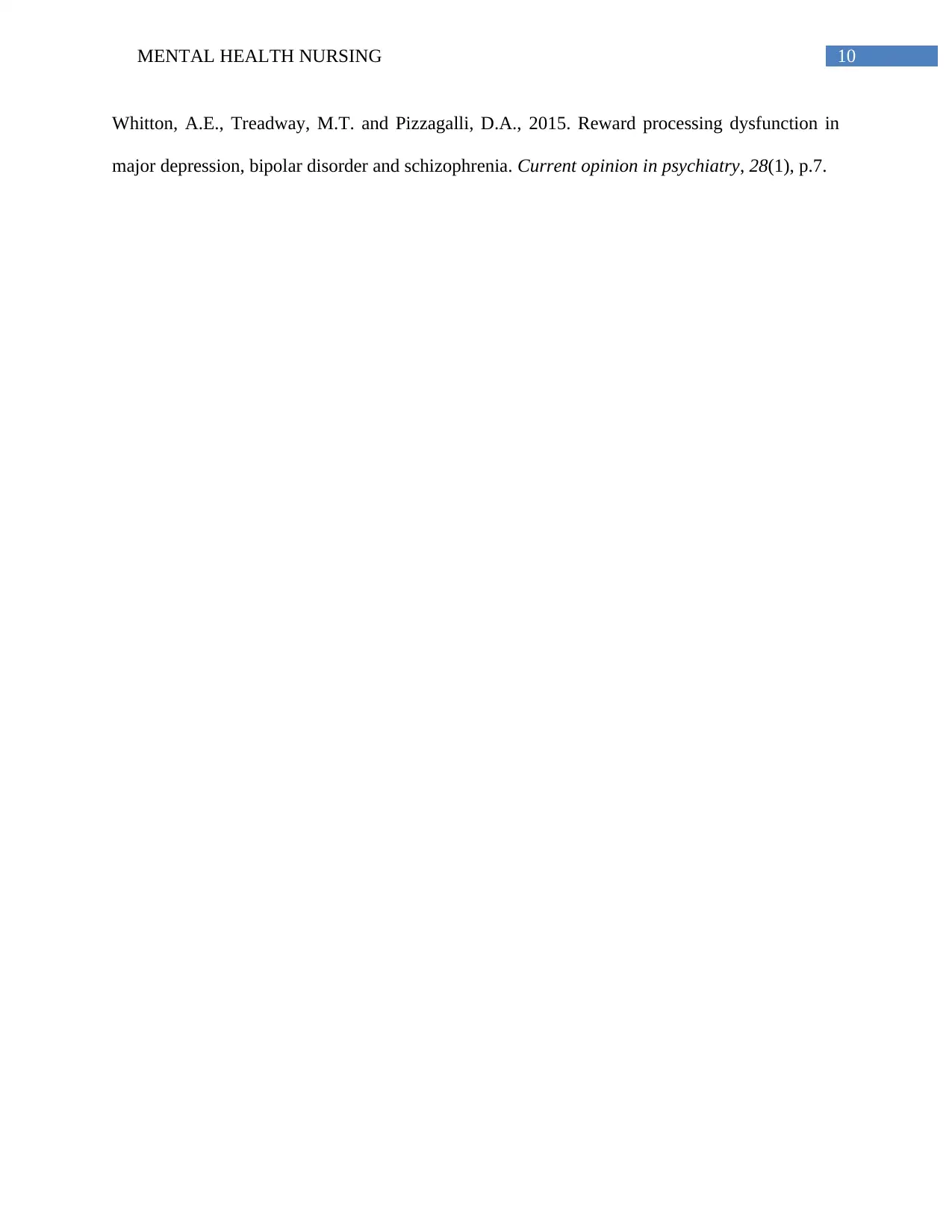
10MENTAL HEALTH NURSING
Whitton, A.E., Treadway, M.T. and Pizzagalli, D.A., 2015. Reward processing dysfunction in
major depression, bipolar disorder and schizophrenia. Current opinion in psychiatry, 28(1), p.7.
Whitton, A.E., Treadway, M.T. and Pizzagalli, D.A., 2015. Reward processing dysfunction in
major depression, bipolar disorder and schizophrenia. Current opinion in psychiatry, 28(1), p.7.
1 out of 11
Related Documents
Your All-in-One AI-Powered Toolkit for Academic Success.
+13062052269
info@desklib.com
Available 24*7 on WhatsApp / Email
![[object Object]](/_next/static/media/star-bottom.7253800d.svg)
Unlock your academic potential
Copyright © 2020–2025 A2Z Services. All Rights Reserved. Developed and managed by ZUCOL.





